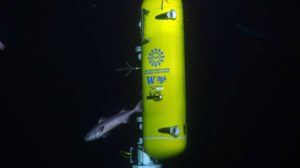During the course of the UW VISIONS at-sea education program, a component of the NSF-funded Ocean Observatories Initiative Regional Cabled Observatory effort, members of the Cabled Array team, educators and students have worked on outreach and engagement products to share their at-sea experiences, their research utilizing Cabled Array data, and information about the amazing technologies used to make this program happen. Examples of these products from 2013 to present are included below: more will be added as future students and educators join the VISIONS program and complete their efforts.

CTD Sampling Tutorial
The video presents an overview of a CTD rosette that includes a variety of oceanographic sensors (conductivity, temperature pressure (depth), fluorometer, pH etc) that measures

Microbes of the Deep
Hydrothermal vents are one of the most extreme environments on Earth, hosting diverse microbial communities that thrive in complete darkness, in the absence of oxygen,

Exploring Full Ocean Depths: Advanced RCA Deep Profilers
In 2024, Paige McKay, a School of Oceanography student with a focus on ocean technology, sailed as a VISIONS student on the Regional Cabled Array.

Skadi Snowblower 2011
One of the most amazing events following the eruptions at Axial Seamount, are billions of microbes, and there biproducts, streaming from collapsed lava lakes at

Life Aboard a VISIONS Expedition
In 2024, University of Washington School of Oceanography and Marine Biology students (Victoria DeJong, Morrigan Havely, and Julie Wiener) collected video to describe what its

A Day in the Life of VISIONS Students at Sea
Every year, as part of the UW experiential at-sea learning program called VISIONS, up to ~20-25 undergraduates participate on the Regional Cabled Array operations and

Islands at 200 m in the Deep Sea
In this video, UW VISIONS’23 student, Emily Pinneo, documents organisms thriving on an RCA Shallow Profiler Mooring platform at 200 m water depth at the

An Introduction to the Geology and Biology of Southern Hydrate Ridge
This video provides an introduction to the geology and biology of Southern Hydrate Ridge, a key observatory site on the Regional Cabled Array, funded by

The CTD – An Informational Resource
This documentary was produced by UW Oceanography student Jenna Fernandez, who sailed on the VISIONS’22 expedition. She is now an engineer at the UW Applied

The Human Network
This video, produced by UW undergraduates Kailey Busch, Katie Hill and Ramaya Ravichandran Asha who participated on the VISIONS’14 expedition, highlights interviews with the Regional

Exploring A Deep Sea Volcano
This video was produced by Riah Buchanan, who was a Ph.D. student at the University of Washington Center for Digital Arts and Experimental Media (DXARTS).

A Look at the ROV Jason
This video was created by University of Washington undergraduates Ashley Lobao and Leeland Wood who participated on Leg 3 of the VISIONS’18 cruise. This video

VISIONS17 Students at Sea
This outreach video was created by Willem Weertman, a UW School of Oceanography undergraduate who participated on Leg 1 of the VISIONS’17 program. The video is meant to serve as a visual guide to what students experience and learn when the

Diel Vertical Migration During a Solar Eclipse
The Great American Eclipse occurred off the Oregon Coast at 10:15am on August 21, 2017, during the third leg of the OOI-UW Cabled Array cruise aboard the R/V Roger Revelle. On the evening before departing on Leg 3 of the cruise, U

From Cruise to the Classroom
In 2017, UW graduate student, Sasha Seroy, sailed on the VISIONS'17 expedition to gain experience in sea-going oceanography using remotely operated vehicles and knowledge about what it takes to operate and maintain the UW-operated Cabled Obs

RV Revelle From Above
Chuck McGuire, a Principal Engineer at the University of Washington Applied Physics Laboratory, and one of the engineering leads on the NSF-OOI-UW Cabled Array project, used a drone during the VISIONS’17 Cabled Array cruise to provide a ra

Interviews with Ocean Scientists
Through interviews with scientists, engineers, students, and robotic vehicle operators involved in the UW VISIONS'17 OOI-NSF Cabled Array expedition, Kevin Eyer (a teacher at the Kingston Middle School), produced this engaging video about th

Creating A Shared Consciousness About the Oceans
Creating A Shared Consciousness About the Oceans: This video was produced by College of the Environment, School of Oceanography undergraduates Katie Bigham and Jesse Turner as part of the Ocean 411 Sea Going Research and Discovery Class.

Extreme Environments and Life at Axial Seamount
Jesse Turner, Katie Bigham and Sam Albertson wrote the script for, and produced, this wonderful video on hydrothermal vents at the summit of Axial Seamount. The video highlights one of the most extreme environments on Earth and the novel life th

Instruments Discovering the Abyss
This fun video "Instruments Discover a Deep Ocean Adventure" was produced by Christina Ramierz. It gives personalities to cutting edge technologies that

Creatures of the Deep on the Juan de Fuca Ridge
One of the VISIONS ’13 student projects is a short video on some of the amazing deep-sea creatures of the Juan de Fuca Ridge.

Communication Break Down
Ryan Cox (VISIONS ’13, Leg 3) wrote this article as his student project.

ROV ROPOS Deployment
Julie Ann Koehlinger (VISIONS ’13, Leg 2) created this video as her student project.

Studying Ocean Patches
Adrian Rembold (VISIONS ’13, Leg 2) interviewed researchers who are studying ocean patches for her student project.

ROV Dives in 3D
Fredrik Ryden (VISIONS ’13, Leg 3) created this video as his student project.

Oceanography in Our Global Future
Isaac Stockdale (VISIONS ’13, Leg 3) created this video presentation as his student project.
